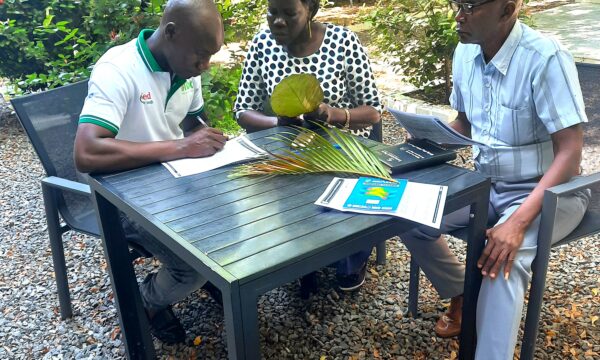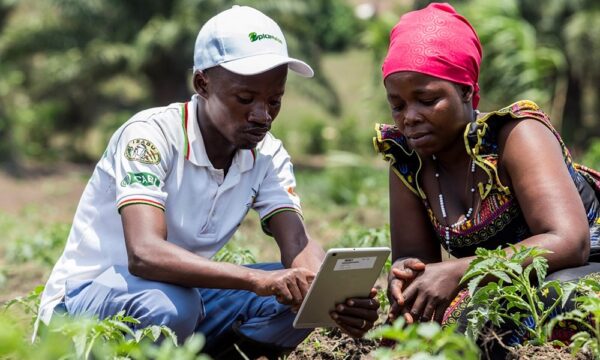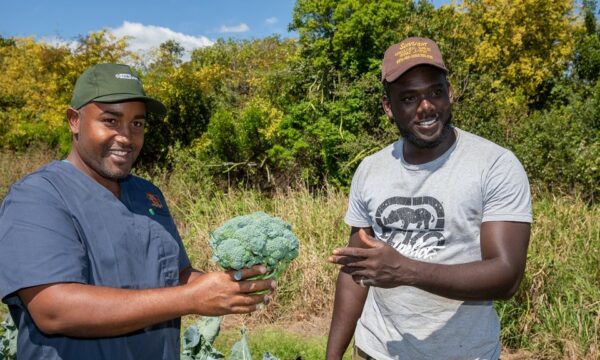The story of support from the Swiss Agency for Development and Cooperation (SDC) for the Plantwise food security programme goes back to its inception in 2011. Since the start, SDC has been a major supporter of both in-country programme activities as well as global resources such as the Plantwise knowledge bank. Sri Lanka is one example of a Plantwise country that has shown particularly strong uptake of the plant clinic concept. This prompted Dr Carmen Thoennissen, an SDC senior advisor for the Global Programme Food Security, to join CABI staff and partners in Sri Lanka for 3 days to discover how the programme is unfolding on the ground and understand what makes it a success. Check out the photo story and read more after the jump
- A farming family visits the plant clinic in Vavuniya. Today it’s estimated that 500 million farming families like this one produce food for over 2 billion people worldwide. (Photo Credit: W. Jenner, CABI)
- Dr Carmen Thoennissen (left) of SDC visits the diagnostic facility at the Horticultural Research and Development Institute (HORDI), Gannoruwa, Kandy District. This facility received approximately 1,000 plant diagnostic queries from plant clinics in 2013. “By continuing to implement as planned this year, I think we will see more and more benefits, especially as these clinics are running regularly in one site,” says research officer Dr M.G.D. Lakmini Priyantha (right). (Photo Credit: A. Rehman, CABI)
- Meeting with Dr D. B T Wijeratne (right from centre), the Additional Secretary, Agriculture Technology, of the Ministry of Agriculture, Sri Lanka, and the national coordinator for Plantwise Mr W.M.P.T Bandara (right), Deputy Director, Plant Protection Service. They discussed the progress of Plantwise since its 2013 launch in the country. “This is information that can inform policy-makers,” says Mr Bandara. (Photo Credit: A. Rehman, CABI)
- Permanent sign in front of a plant clinic location in Anuradhapura District, indicating the fixed date and time of the plant clinic. “Here the farmers can bring their samples to a common place, and they can expect some remedy for their problems,” says Provinical Director of Extension, Mr M B Dissanayaka. (Photo Credit: W. Jenner, CABI)
- A plant clinic in operation at a community centre in Anuradhapura District. Three teams of plant doctors (government extentions workers), each focus on a different category of crops, examine the sick plants and provide advice. This plant clinic can sometimes have more than 100 farmers at a single session. (Photo Credit: A. Rehman, CABI)
- The plant doctor works from a Green & Yellow List, one Plantwise tool where they find safe pest management options for farmers, and records the diagnosis and recommendation in a prescription pad. ”These farmers are using less chemicals,” says one plant doctor. “We’d like more training because the farmers come and we can help them here.” (Photo Credit: W. Jenner, CABI)
- Two plant doctors who were trained in 2013 by national trainers with support of CABI staff including Abdul Rehman (left) now run and organize their own plant clinics in teams like this one today. (Photo Credit: W. Jenner, CABI)
- Farmers, once registered and given a visit number, wait patiently with their various plant samples until a plant doctor calls on them for their consultation. Farmers have all gathered here from the surrounding villages to consult the plant doctors. “We receive answers here,” says women farmer with a gourd boorer problem from Menikdiwela. (Photo Credit: W. Jenner, CABI)
- CABI’s Malvika Chaudhary looks on as plant doctors ask the farmer questions and proceed to record their diagnosis and recommendation, with a sign announcing the type of crops they attend to at that table. This year, national teams in Sri Lanka will begin to review these clinic records to help target training and ensure the quality of advice for farmers. (Photo Credit: A. Rehman, CABI)
- Outside the clinic, Research Officer W. M. D. H. Kulatunga with the Department of Agriculture speaks to CABI’s Wade Jenner about the extension materials created and displayed by plant doctors here in local language. “It’s impressive to see the level of committment and ingenuity of plant doctors here to deliver messages farmers can relate to.” (Photo Credit: A. Rehman, CABI)
- Sakeela Banu (right), the Deputy Provincial Director of Extension in Vavuniya District, talks with Agriculture Officer M. U. P. Jayasundara from Gannoruwa about plant clinic activities in her area, including how this modified ‘tuk-tuk’ (3-wheeler) is used to announce plant clinic events. (Photo Credit: A. Rehman, CABI)
- Dr Thoennissen (SDC), Ms Banu and Ms Chaudhary discuss the provision of advisory services to farmers. “When we have the clinics, nearly 30 or 40 farmers are gathering there,” explains Ms Banu (left). “Some come with problems and some come for a chat, to share their needs and what they expect from us in the extension department. We can have a close link with the farmers.” (Photo Credit: A. Rehman, CABI)
- A plant doctor consults a farmer on his crop problem and writes down a diagnosis and advice. One copy of the ‘prescription’ goes to farmer while another is kept so that the information can be entered into a national database, which is then used to inform priorities in research, extension and policy in the country. (Photo Credit: W. Jenner, CABI)
In Sri Lanka, the ‘Permanent Crop Clinic Programme’ is expanding quickly. In 2013 alone, over 200 extension officers were trained on ‘How to Become a Plant Doctor’ and are now establishing plant clinics across the country, advising farmers and gathering valuable field data that will help to inform extension and policy to tackle real challenges facing farmers. “Because farmers don’t know how to use pesticides, they misuse, overuse as well as abuse. We have to stop that,” says Dr D. B T Wijeratne, the Additional Secretary on Agriculture Technology at the Ministry of Agriculture (MoA). Following meetings with MoA officials including in Colombo, the delegation journeyed to Kandy to hear from the Permanent Crop Clinic Programme national coordinator, the plant clinic data management team, and a research institute which provides pest diagnostic support. “Plantwise fills a need,” said Mr M.U.P. Jayasundara, Agricultural Officer with the Plant Protection Service, the national implementing partner. “We can use the plant doctor prescription sheet as a requirement to show the agro-dealers to receive inputs, providing a sort of checks and balances on pesticides.”
The tour concluded with a visit to the heart of Plantwise – plant clinics run by local extension staff at the village level, one in Anuradhapura District and one in Vavuniya District, both managed professionally by plant doctor teams drawing numbers of farmers seeking advice. “It has helped me in organizing, decision-making and covering a large extension area- 37 villages with over 75 farmers each,” says plant doctor Maheshika Wirkranakaluthe. “And now the farmers’ tendencies are going towards non-chemical solutions as well, so this is very positive.” It was evident that the plant clinics were a concept that the farmers not only understood well, but also appreciated, as demonstrated by the numbers who turn up repeatedly for advice. “Whenever I have a problem, I go to the clinic,” says one farmer from Hettiwatha.
To find out more about Plantwise, please visit www.plantwise.org
And visit the SDC’s Food Security website at: http://www.sdc.admin.ch/en/Home/Themes/Agriculture_and_food_security
1 Comment
Leave a Reply
Related News & Blogs
Plant clinics showcased at Harvest Money Expo in Uganda to help empower the country’s young smallholder farmers
The CABI-led PlantwisePlus programme showcased its plant clinics at the Harvest Money Expo in Uganda to help empower the country’s young smallholder farmers to grow more and lose less to potentially devastating crop pests and diseases. The Harvest Mone…
22 March 2024


















I am really enjoying the theme/design of your web site.
Do you ever run into any internet browser compatibility issues?
A small number of my blog visitors have complained about my website not working correctly in Explorer but looks great in Firefox.
Do you have any tips to help fix this problem?